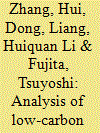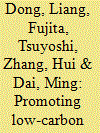|
|
|
Sort Order |
|
|
|
Items / Page
|
|
|
|
|
|
|
| Srl | Item |
| 1 |
ID:
125659


|
|
|
|
|
| Publication |
2013.
|
| Summary/Abstract |
CO2 mitigation strategies in industrial parks are a significant component of the Chinese climate change mitigation policy, and industrial symbiosis can provide specific CO2 mitigation opportunity. Technology is important to support symbiosis, but few studies in China have focused on this topic at the industrial park level. This research presented a case study in a national iron and steel industrial park in China. Focus was given onto carbon mitigation through industrial symbiosis technology using substance flow analysis (SFA). Three typical iron and steel industry technologies, including coke dry quenching (CDQ), combined cycle power plant (CCPP), and CO2 capture by slag carbonization (CCSC) were evaluated with SFA. Technology assessment was further conducted in terms of carbon mitigation potential and unit reduction cost. Compared with the Business as usual (BAU) scenario, application with CDQ, CCPP, and CCSC reduced the net carbon emissions by 56.18, 134.43, and 222.89 kg CO2 per ton crude steel inside the industrial parks, respectively, including both direct and indirect emissions. Economic assessment revealed that the unit costs for the three technologies were also high, thereby necessitating national financial support. Finally, relevant policy suggestions and future concerns were proposed and discussed.
|
|
|
|
|
|
|
|
|
|
|
|
|
|
|
|
| 2 |
ID:
125588


|
|
|
|
|
| Publication |
2013.
|
| Summary/Abstract |
China launched low-carbon city strategy to respond global climate change. Industrial symbiosis (IS) could generate both economic and environmental benefits in clustered industries and communities. This research shed light on how industrial symbiosis contributes to city's low-carbon development. An urban-level hybrid physical input and monetary output (HPIMO) model which covers physical energy inputs and air pollutants emissions, is established for addressing case study in a Chinese typical industrial city (Liuzhou). Based on current energy consumption and industrial symbiosis and the application of HPIMO model, scenarios related to industrial symbiosis, including waste plastics recycling, scrap tires recycling, flying ash recycling and biomass utilization are explored. Results show that compared with business-as-usual (BAU) scenario, IS can reduce solid wastes and further contribute to the co-benefits of energy saving, CO2 emissions reduction and air pollutants reduction. The finding is critical for national low-carbon strategy. Finally, policy implications to support the ever-improvement of IS promotion in China are proposed and discussed.
|
|
|
|
|
|
|
|
|
|
|
|
|
|
|
|
|
|
|
|
|